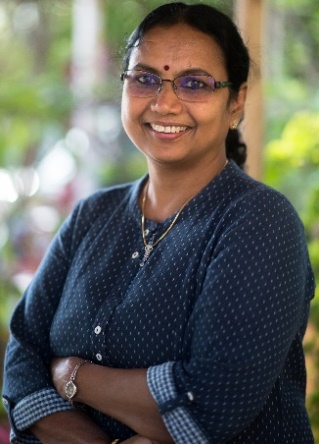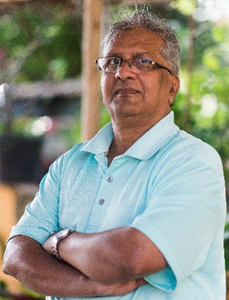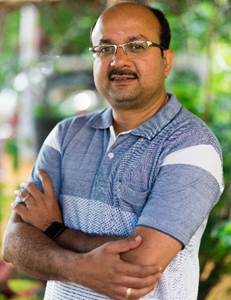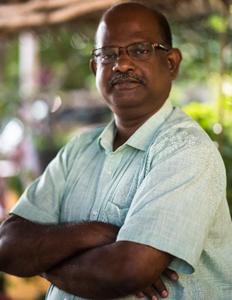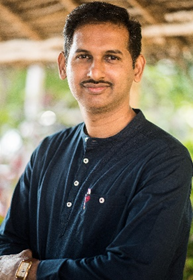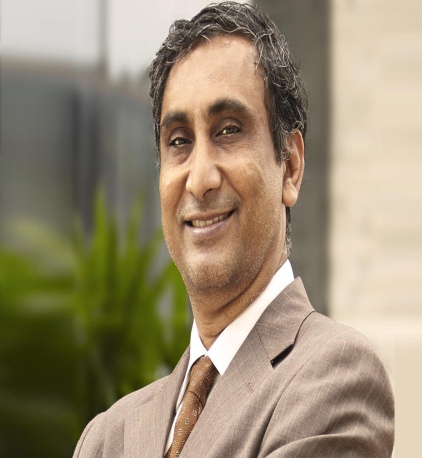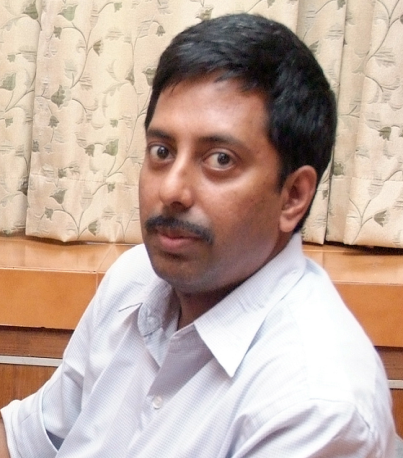Project
The overarching aim of this research initiative is to solve challenging problems in water management using the framework of circular economy in order to achieve sustainability and water security in the backdrop of rapidly developing economies and impending climate change. This will involve development of new reliable process models for water resources, next generation technologies for water and wastewater treatment, novel sensors for monitoring water quality, application of IoT for online monitoring and control, and new paradigms for water infrastructure planning.



Experimental, field level pilot-scale and mathematical modeling studies will be conducted to address interrelated research problems which overlap the three main water use sectors of industrial, domestic and agriculture as depicted in the graphical abstract below.

Research Problems to be Addressed in Agricultural Water
- Better estimation of water availability now and in future through improved understanding of hydrological processes
- Reduce water consumption by increasing irrigation efficiency
- Supplement water resources through recycling
- Supplementary nutrients recovered from domestic, industrial and agricultural waste
- Management of agricultural runoff
- Tackling nutrients and pesticides in agricultural runoff


Research Problems to be Addressed in Domestic Water
- Improved drinking water quality through advanced treatment
- Monitoring quality and quantity through appropriate sensors and IoT
- Supplementary water through recycling and reuse
- Optimal design and operation of water supply systems
- Reduction of water losses in the distribution system
- Improving the resiliency of water supply

Research Problems to be Addressed in Industrial Waste
- Process modification to reduce water usage and waste generation
- Waste minimization through reuse in down stream industries
- Recycle and resource generation
- Toxicity and risk analysis
- Monitoring, sensors, IoT

Research Problems to be Addressed in Wastewater
- Greywater for agriculture and other secondary uses
- Appropriate technologies for recycling
- Nutrient and energy recovery
- Appropriate technologies for removal of Emerging contaminants and residual pollution
- Sensors and IoT for continuous quality monitoring
- Sustainability assessment of process through LCA
- Risk assessment

Scope
- Establish a hydrologic observatory for obtaining comprehensive data on hydrological processes in a heavily irrigated biosphere, and use the data for improving hydrologic models
- Improve modeling of un-gauged basins by assimilating remotely sensed data
- Evolve climate change adaptation practices for water management considering uncertainties
- Detection and quantification of ECs, pathogen and micro-plastics in diverse environments
- Develop advanced treatment processes and management plans for halting ECs, ARGs, MRGs
- Explore the linkage between ARGs/MRGs and human health risk
- Develop appropriate proof of concept for processes for water and nutrient recovery from different wastewaters and bio-solids and understand the mechanism of the pollutants removal
- Develop decision support system for tools for process selection and optimization
- Develop planning and design models for integrated water infrastructure to address the multiple issues of water scarcity, flooding and environmental protection.
- Use Data Science and IoT for monitoring and control of large water distribution networks.
- Develop an integrated water quality sensor for comprehensive characterization of metals, salts and ion concentrations in water.
- Develop multi-parameter sensor for measuring water quality and sludge depth in water tanks
Publications
We aim to publish at least 30% to 50% of our publications in top 10% journals in the research field. Remaining will be published in Q1 journals.
New instruments/Facilities:
-
- State of the art analytical facilities for Environmental systems
-
- Flux towers for field level measurement of H2O and CO2
-
- Fully automatic Weather stations
-
- Completely instrumented catchment,
-
- Data acquisition and electronic development systems
-
- Sensors, actuators, network elements, IoT platforms,
-
- Field experimental/demonstration stations
Technologies, Processes & Models

Current status
Detection and Removal of Nitrate and Phosphate and P

Nutrient Removal using Ion Exchange Membranes (Donnan Dialysis)
- Donnan dialysis is an ion exchange process where an ion exchange membrane separates two chambers (receiver and feed) with different electrolyte concentrations.
- Nutrients from the feed are concentrated in the receiver chamber due to concentration gradient.
- Donnan dialysis requires less energy compared to other technologies.

Value Addition to Waste Materials and its Utilization in Wastewater Remediation

Performance of Constructed Wetland Systems for Wastewater Treatment

Performance Evaluation of Ceramic Membrane as Tertiary Treatment Systems for Domestic Wastewater
- Quality of treated water from CF outlet » (UF) outlet
- Treated water quality falls within the reuse standard
- Reused for non-potable secondary applications at safer level

Greywater Treatment and Reuse System
- Lab scale anaerobic attached coir reactor (AACR) was developed for the treatment of bathroom greywater with aim of removal of organics such as BOD and COD.
- Followed by biological reactor, the greywater is treated using coagulation and ultrafiltration (UF).

Water Treatment- Removal of Emerging Contaminants
- Polymeric membranes were prepared using different nano-composites (GO-ZnO, GO-ZnO-Ag, GO-Ag, etc.). The application of membranes in water treatment is in progress
- UV and visible-light based photocatalysts (Ag-TiO2, Fe-TiO2, Chitosan and carbon based composites, etc) are prepared and applied for emerging pollutants removal
- New adsorbent(s) are developed and applied for multi-antibiotic and multi-nutrient removal experiments
- Initial experiments for developing database of UV spectral signatures of chromium ions performed (one post-doctoral fellow is working on this)
Water Treatment- Removal of Emerging Contaminants
-
Ecofert (Recovery of fertilizers and water from human waste): Prototype of 50L /batch developed. Plan is on for development of full scale plant.
-
AMR Flows: Sampling of Adyar river and waste water treatment plant discharges is carried out. Analysis for antibiotics and Antibiotic resistant genes is ongoing

Resource Recovery From Wastewater
Diagrams and photograph of some of the sensor systems developed

Sensors for Water Quality Monitoring
(Integrated water quality sensor for comprehensive characterization of metals, salts and ion concentrations in water)
- One post-doctoral student currently employed on project
- Initial experiments for developing database of UV spectral signatures of chromium ions performed

Water Networks
- Lab network upgrade
- Data driven operation of water networks- lab verification
- Leak detection using transient models

Development of an Agro-Hydrologic Observatory
Development of an Agro-Hydrologic Observatory
- A test bed for developing and validating satellite based estimates of agro-hydrologic variables such as:
- Evapotranspiration, Soil moisture
- Irrigation diversion and irrigation efficiency
- Enhanced agro-weather forecasting system to improve irrigation efficiency and agricultural productivity
- Improved representation within hydrologic models
- Adaptability and Sustainability of the current system to climate change
- Potential sites for field observatory has been identified
- Procurement of field equipment are on-going
- Development of satellite based disaggregation algorithm for field scale estimation of ET is in progress
- Development of a global soil database for hydrological modelling based on geo-spatial modelling with remotely sensed data
Integrated Network Design

Current Status (Publications)
- Vaishali Choudhary, Kowsalya Vellingiri, Mohammed Iqbal Thayil and Ligy Philip (2021). Removal of antibiotics from aqueous solutions by electrocatalytic degradation : Critical Review. Environmental Science- Nano-DOI: 10.1039/d0en01276.
- Onkar Sudhir Ekande and Mathava Kumar* (2021), Facile synthesis of graphitic carbon nitride from acetic acid pretreatment to activate persulfate in presence of blue light for photocatalytic removal of metronidazole, Chemosphere, 276, 13017
- Manjunath S V, and Mathava Kumar* (2021), Simultaneous removal of antibiotic and nutrients via Prosopis juliflora activated carbon column: Performance evaluation, effect of operational parameters and breakthrough modeling, Chemosphere, 262, 127820.
- Neghi, N., Gayathri, R and Mathava Kumar* (2021), Synthesis and application of CS-GO composite and GAC-TiO2 for adsorptive and photocatalytic removal of antibiotics, ASCE J. Haz. Tox. Radioac. Waste Manage. (In Press).
- Bhuvaneswari, R., Jeyanthi, J., Mathava Kumar S (2021), Visible light assisted degradation of Atenolol by Fe-TiO2: Synthesis, characterization, optimization and mechanism, Optik, (online).
- Jerin Jose, and Ligy Philip (2021) " Continuous flow pulsed power plasma reactor for the treatment of aqueous solution containing volatile organic compounds and real pharmaceutical wastewater" Journal of Environmental Management, Volume (286) Article No:112202, DOI: 10.1016/j.jenvman.2021.112202
- Manthiram Karthik. R, and Ligy Philip (2021) “Sorption of pharmaceutical compounds and nutrients by various porous low-cost adsorbents” Journal of Environmental Chemical Engineering, Volume 9(1) Article Number:104916, DOI: 10.1016/j.jece.2020.104916
- Jerin Jose, and Ligy Philip (2021) " Comparative study of degradation of toluene and methyl isobutyl ketone (MIBK) in aqueous solution by pulsed corona discharge plasma" Journal of Environmental Sciences, Volume (101) Page No:382-396, DOI: 10.1016/j.jes.2020.09.003
- Many are under review
Collaborations
Our Collaborators
- Dr. Christoph Lüthi Head: Sanitation, Water and Solid Waste for Development,EAWAG, Switzerland link
- Dr. George Tchobanoglous-Professor Emeritus, Department Of Civil And Environmental Engineering University Of California DAVIS
- Dr. Martin Kranert-Professor, University of Stuttgart, Germany link
- Dr. Sonia Grego-Asso. Research Professor , Duke University, USA link
- Dr. Yoram Oren- Emeritus Professor, Ben-Gurion University of the Negev, Israel link
- Dr. Zeev Ronen - Professor, Ben-Gurion University of the Negev, Israel link
- Dr. Jack Gilron - Associate Professor, Ben-Gurion University of the Negev, Israel link
- Dr. Fayyaz Ali Memon - Professor, University of Exeter, United Kingdom link
- Dr.-Ing. Heidrun Steinmetz- Professor, Wasser Infrastruktur Ressourcen Paul-Ehrlich-Str. 14 Building 14 , Room 313 67663 Kaiserslautern link
- Prof. Wenshan Guo-Professor, School of Civil and Environmental Engineering,University of Technology Sydney (UTS)15 Broadway, Ultimo, NSW, Australia link
- Dr. Huu-Hao Ngo - Professor, School of Civil and Environmental Engineering,University of Technology Sydney (UTS)15 Broadway, Ultimo, NSW, Australia link
- Dr. Raghavan Srinivasan- Regents Fellow Professor-Director, Spatial Sciences Laboratory, Texas A&M University, USA link
- Dr. -Ing. Nicola Fohrer - Professor & Director Institute for Nature and Resource Conservation University of Kiel, Germany link
- Dr. Jeffrey G. Arnold- Agricultural Engineer USDA – ARS, USA link
- Dr. Peter Fiener- Professor, Water and Soil Resource Research Department of Geography, University of Augsburg, Germanu link
- Dr. Indrajeet Chaubey- Dean and Director College of Agriculture, Health and Natural ResourcesUNIVERSITY OF CONNECTICUT
- Dr.-Ing. Ulrich Dittmer- Professor, Wasser Infrastruktur Ressourcen Paul-Ehrlich-Straße 14 Gebäude 14 , Raum 309 67663 Kaiserslautern link
- Dr. Maryam Imani- Senior Lecturer School of Engineering and the Built Environment Faculty of Science and Engineering Anglia Ruskin University Chelmsford, CM1 1SQ United Kingdom
- Dr. Subhas C. Mukhopadhyay- Professor, Macquarie University, Australia link
External International Site Links for Project
International education programs, conferences / seminar / webinar
- 14th International Conference on Sensing Technology, Jan. 2022, at IIT Madras
- AQUA≈360: Water for All - Emerging Issues and Innovations. Virtual Conference; Exeter, UK, August 31-September 2, 2021 (Co-Chair – Prof. Ligy Philip). PCoE has five papers in the conference
Industrial Collaborations
- M/S Saint Gobain- Ceramic filters for water and wastewater treatment and recycles
- M/S Torray, Japan: Membrane bioreactors for wastewater management
- M/S Greenvironment Pvt. Ltd: Sensors and wastewater treatment
- M/S Thirumala Chemicals Ltd: Bioremediation of contaminated soil and ZLD system for industrial effluent
- M/s Tamil Nadu Water Investment Company (TWIC): Planning of Water Infrastructure (WIS)
- M/s Ingenieurbuero Scheer (IBS) ; Oberstdorf, Germany: Planning of WIS
- M/s Tandler.com (TAN) Gesellschaft für Umweltinformatik mbH; Buch am Erlbach; Planning of WIS
- M/s Bharat Heavy Electricals Limited
- M/s Amaraja Batteries
Societal impact
Research in circular economy will immensely help urban local bodies such as CMWSSB, commercial and industrial establishments, institutions to achieve substantial water savings by wastewater recycling. Water recycling technologies proposed here will have direct implications on ecological health by preventing eutrophication. The research directly helps the national programs such as Swatch Bharat Abhiyan, Atma Nirbar (Self-reliance) in fertilizers and development of healthy villages and cities.
Outcomes from this research will result in significant savings in the water use in the agricultural sector. It will help state and local governments for managing water in small un-gauged catchments. Pathogen monitoring and assessment can help in identifying the source of disease and the extent of spread. This will be very helpful for the society, medical professionals and the government to take appropriate informed decision for control and containment. The new technology/process developed can be used for safe drinking water supply/ industrial wastewater management etc.
Research outcomes will help in planning sustainable and smart water infrastructure by any urban local body or municipality. The newly developed sensors will change the way water quality monitoring will be carried out in future, and will have direct impact on the public health.
Sustenance Statement
Majority of the group members already have large international funded projects. This momentum will be used to submit new proposals seeking funds from international funding agencies. The international collaborations of group members will be leveraged to attract large multi-national projects
Members of the group have been executing many projects sponsored by national and multi-national industries, foundations (Eg: Bill and Melinda Gates Foundation) and other international agencies. These organizations will be approached for substantial increase in funding, by showcasing our success with international collaborations.
Several of group members are actively involved in product patenting, technology transfer and commercialization. This will also bring grants/funds for the continuation of the centre.
The work being carried out by the group members has significant social impact and relevance. They have been successful in attracting large CSR funds from Indian industry so far. Successful international collaborations will be leveraged to attract CSR funding from the many multi-national companies operating in India.
Members of the group have been helping many Govt. bodies like Chennai Metropolitan Water Supply and Sewerage Board (CMWSSB). This will be leveraged to obtain funding from many central and state governmental agencies for research based consulting assignments.
References
- startup-samudhyoga-waste-chakra-ecofert-converting-urine-to-water
- advance-global-research-technologies-in-sanitation-public-health
- grant-to-field-test-new-sanitation-technologies
Technical/ Scientific Progress
New work done in the project
NEW WORKDONE IN THE PROJECT
- Performance of constructed wetlands has been evaluated both on lab-scale and field scale systems. It has been found that waste autoclaved aerated concrete blocks are found to be best suited as substrate. Organic and nutrient removal was 85-93%. 14 PPCPs were monitored, and the removal was from 84.8 to 98%. Treated wastewater can be used for gardening & composting purposes.
- Low-cost colorimetric sensors have been developed for the detection of aqueous eutrophying ions. They are verified using real samples and cost analysis was carried out for real-world applications.
- Carbonized absorbent derived from waste has been assessed for adsorption of pharmaceuticals and personal care products. Batch scale verification of the developed adsorbent for removal of PPCPs has been completed.
- Experiments have been conducted for electrosorptive removal of phosphate.
- Ion Exchange Membrane (Donnan Dialysis) process has been developed for removal of oxyanions. Donnan dialysis requires less energy compared to other technologies.
- Processes for deriving char from waste materials (value addition to industrial sludge; biological sludge; agricultural waste; food waste and plastic waste) have been developed. It is demonstrated that this char is an excellent material for wastewater remediation & reuse.
- Algae-bacterial system is being derived for nutrient and emerging contaminants removal.
- Hybrid aeration-advanced oxidation Process has been developed and its performance has been evaluated for the treatment of MEE reject.
- Synthesis of magnetic CaFe2O4 and MgFe2O4 Nanoparticles and their application
- Sonocatalysis with magnetic nanoparticles for dye degradation
- Synthesis and application of Starch and powdered activated carbon amended alginate-biomass beads for emerging pollutants and organic matter removal
- Preparation of Amino-Clay and graphene oxide incorporated thin-film nano-composite membrane and its application of water treatment
- Preparation, characterization and application of alginate-biomass beads for antibiotics removal
- Development and evaluation of a low cost flow sensor.The work is under review for publication in IEEE Sensors Journal. Figures for the website will be given once the paper is accepted.
- Development of an online sensor system for nitrite sensingThe work is in progress. Initial test results are good. We are in the process of designing the full system and fabricating it.
- Development a non-intrusive measurement mechanism to read from the cantilever based flow sensor. Sensor optimization is in progress.
- Data driven models are integrated with first principle models for water distribution networks. Data driven techniques based on On/off valve operations or continuous valves & available measurements are developed for scheduling problem. Herein, hydraulic model for network sis not needed. Paper is communicated to the journal Water Resources Management.
- Algorithms for learning and control of WDNs have been developed. Lab verification of data driven scheduling algorithm using discrete and continuous control valves is completed.
- IoT based devices for water network monitoring and controls have been tested in laboratory and field testing is in progress. New capacitance based sensors are designed and installed.
- Software for design of WDNs has been initiated. Python based web application has been developed and will be released soon.
- Software for scheduling of WDNs operated with On/Off valves is completed. Python based web application has been developed and will be released soon.
- Well-known Thevenin theorem from Electrical Engineering field is adapted for developing computationally efficient tools for WDN analysis, wherein the focus is on a sub-network connected with a large existing pipe network.
- A design tool based on simulation-optimization framework has been developed for integrated design of sewerage systems along with water supply systems, with recycling of treated wastewater, has been developed. Applicability has been demonstrated.
- A methodology has been developed for site suitability analysis with GIS and Multi-criteria approach for Sustainable urban Drainage System (SuDS) components. The site suitability maps of SuDS components can be effectively integrated with the urban planning and development framework. Preliminary results are obtained for Chennai basin.
- Dynamic Downscaling has been applied to study climate change impacts on water resources in India. Sensitivity experiments helped to gain some major insights into how such studies should be carried out and the climate change impact variation across the country.
- Agro-hydrological model, Soil and Water Assessment Tool (SWAT) is being improved for parameterization in a system dominated by agriculture using Time series of Vegetation Indices and Evapotranspiration (ET) from satellite measurements. SWAT model is being customized to run in gridded framework for this purpose.
- SWMM-HYDRUS 1D coupled model has been developed for assessment of SUDs performance. Preliminary results are obtained for IITM campus.
- A simulation- optimization platform using an improved SWAT model formulation for LIDs is being developed to estimate the most suitable combination of LIDs for hydrologically similar areas. This will be scaled up for LIDs on river basin scale.
- Changes in hourly to daily scale extreme precipitation across Indian-subcontinent are being analysed using data from observed, reanalysis and satellite data and associated physical covariates to assess the impacts of urbanization on precipitation extremes.
Infrastructure developments
- Purchase orders have been issued for the following major analytical equipment
- Atomic Absorption Spectrometer (Delivered)
- Gas Chromatography - Mass Spectroscopy
- High Performance Liquid Chromatography
- Ion Chromatography
- Fluorescence Microscope
Purchase orders have been issued for the following instruments / equipment for upgradation of Environmental Engineering Laboratory Incubator shaker; Laminar flow chamber; Autoclave (vertical type); N2 evaporator; PERISTALTIC PUMPS- 3 nos; Sonicator (water bath); Vacuum filtration setup (pump, plastic holding cup (2 nos), and collection flask (2 nos)); Weighing balance; High Voltage Connector; Air Compressor; Digital Ultrasonic Cleaner - 1 No; Vernier-Sensors; Wall Table (With Teak Wood frame) for AAS Instrument; Microwave Synthesis system with condenser and temperature controller, and also with HD LCD screen with HD Camera to monitor the reactions - 1 No;
Water Distribution Network laboratory is being upgraded System for electronic development(5 NOS); 2 Inline flow meters; 8 numbers Motorized control valve with cables; 10 Pressure transducers with connecting pins; 20 Ultrasonic level sensors with cables; Data acquisition system with accessories
Purchase orders placed for following sensors for Sensors Laboratory Ion selective electrodes for quality monitoring; Quality (TDS Sensor); Quality pH Sensor ; Amperometric Chlorine Sensor (free chlorine)
Purchase orders have been issued for the following equipment for setting up field hydrological research station Guelph Permeameter (1 No.)
Tenders have been placed for the following equipment for setting up field hydrological research station Eddy Covariance Flux Tower (1 No.); Automatic Weather Station & Infrared Canopy Temperature (2 Nos.); Automatic Rain Gauge & Multi-level Soil Moisture and Soil Temperature Sensor (7 Nos.); Waterlevel data loggers (Surface and Groundwater) (16 Nos.); Digital Plant Canopy Analyzer
Output
International Journal Publications:
- Ravichandran M.K, Yoganathan.S and Ligy Philip (2021) “Removal and risk assessment of pharmaceuticals and personal care products in a decentralized greywater treatment system serving an Indian rural community” Journal of Environmental Chemical Engineering, Volume 9, Issue – 6, Article Number: 106832, DOI: 10.1016/j.jece.2021.106832
- Choudhary, V and Ligy Philip (2021) “Stable paper-based colorimetric sensor for selective detection of phosphate ion in aqueous phase” Microchemical Journal, Volume 171, Article number 106809, DOI: 10.1016/j.microc.2021.106809
- Nippatla N, Kamaraj Ramakrishnan and Ligy Philip (2021) “Enhanced degradation of complex organic compounds in wastewater using different novel continuous flow non – Thermal pulsed corona plasma discharge reactors” Environmental Research, Volume 203 Article number 111807, DOI: 10.1016/j.envres.2021.111807
- Jayakumar Renganathan, Insamam Ul Huq S, Kamaraj Ramakrishnan, Ravichandran M.K, and Ligy Philip (2021) “Spatio-temporal distribution of pharmaceutically active compounds in the River Cauvery and its tributaries, South India” Science of The Total Environment, Volume 800, Article Number: 149340, DOI: 10.1016/j.scitotenv.2021.149340
- Ravichandran M.K, and Ligy Philip (2021) “Insight into the uptake, fate and toxic effects of pharmaceutical compounds in two wetland plant species through hydroponics studies” Chemical Engineering Journal, Volume 426, Article Number: 131078, DOI: 10.1016/j.cej.2021.131078
- Choudhary, V., Vellingiri, K., Ligy Philip (2021) “ Potential nanomaterials-based detection and treatment methods for aqueous chloroform” Environmental Nanotechnology, Monitoring and Management, Volume 16, Article number 100487, DOI: 10.1016/j.enmm.2021.100487
- Krithika, D, Sharon, H, Reddy, K.S and Ligy Philip, (2021) “Performance evaluation of solar thermal systems as an alternative for human waste treatment” Sustainable Energy Technologies and Assessments, Volume 47, Article Number: 101393, DOI: 10.1016/j.seta.2021.101393
- Choudhary, V., Vellingiri, K., Thayyil, M.I., Ligy Philip (2021) “ Removal of antibiotics from aqueous solutions by electrocatalytic degradation” Environmental Science: Nano, Volume 8, Issue 5, Pages 1133 – 1176, DOI: 10.1039/d0en01276a
- Jerin Jose, and Ligy Philip (2021) " Continuous flow pulsed power plasma reactor for the treatment of aqueous solution containing volatile organic compounds and real pharmaceutical wastewater" Journal of Environmental Management, Volume (286) Article No:112202, DOI: 10.1016/j.jenvman.2021.112202
- Manthiram Karthik.R, and Ligy Philip (2021) “Sorption of pharmaceutical compounds and nutrients by various porous low-cost adsorbents” Journal of Environmental Chemical Engineering, Volume 9(1) Article Number:104916, DOI: 10.1016/j.jece.2020.104916
- Jerin Jose, and Ligy Philip (2021) " Comparative study of degradation of toluene and methyl isobutyl ketone (MIBK) in aqueous solution by pulsed corona discharge plasma" Journal of Environmental Sciences (China), Volume (101) Page No:382-396, DOI: 10.1016/j.jes.2020.09.003
- Saptarshi Bose, S., Tripathy, B.K., Debnath, A., Mathava Kumar* (2021), Boosted sono-oxidative catalytic degradation of Brilliant Green dye by magnetic MgFe2O4 catalyst: Degradation mechanism, assessment of bio-toxicity and cost analysis, Ultrasonics Sonochemistry, 75, 105592. (DOI:10.1016/j.ultsonch.2021.105592).
- Onkar Sudhir Ekande and Mathava Kumar* (2021), Review on polyaniline as reductive photocatalyst for the construction of the visible light active heterojunction, J. Environ. Chem. Engg., 9(4), 105725. (DOI: 10.1016/j.jece.2021.105725).
- Girijan, S., Mathava Kumar*, Gomber, S. (2021), Starch and powdered activated carbon amended alginate-biomass beads for metronidazole and bulk organic matter removal: Synthesis, optimization, reaction kinetics and reusability, J. Environ. Chem. Engg., 9(5),106102. (DOI: 10.1016/j.jece.2021.106102).
- Mukhopadhyay, A., Tripathy, B.K., Debnath, A., Mathava Kumar* (2021), Enhanced persulfate activated sono-catalytic degradation of Brilliant Green dye by magnetic CaFe2O4 nanoparticles: Degradation pathway study, assessment of bio-toxicity and cost analysis, Surfaces and Interfaces, 26, 101412. link.
- Rabiul Islam, Md., Khurana, P, Srikrishnarka, P, Nagar, A, Jash, M, Jenifer, S.K., Ganayee, M.A., Mathava Kumar*, Pradeep, T* (2021), Aminoclay-Graphene Oxide Composite for Thin-Film Composite Reverse Osmosis Membranes with Unprecedented Water Flux and Fouling Resistance, Advanced Materials Interfaces, 2100533. link
- Rajasekhar, B., Nambi, I. M., & Govindarajan, S. K. (2021). Investigating the degradation of nC12 to nC23 alkanes and PAHs in petroleum-contaminated water by electrochemical advanced oxidation process using an inexpensive Ti/Sb-SnO2/PbO2 anode. Chemical Engineering Journal, 404, 125268.
- Malek, A., Ganta, A., Divyapriya, G., Nambi, I. M., & Thomas, T. (2021). Hydrogen production from human and cow urine using in situ synthesized aluminium nanoparticles. International Journal of Hydrogen Energy, 46(54), 27319-27329.
- Srinivasan, R., Rajasekhar, B., & Nambi, I. M. (2021). Deterministic and probabilistic health risk assessment for exposure to non-steroidal anti-inflammatory drugs in an Indian river. Environmental Science and Pollution Research, 1-14.
- Sivagami, K., Tamizhdurai, P., Mujahed, S., & Nambi, I. (2021). Process optimization for the recovery of oil from tank bottom sludge using microwave pyrolysis. Process Safety and Environmental Protection, 148, 392-399.
- Sivagami, K., Divyapriya, G., Selvaraj, R., Madhiyazhagan, P., Sriram, N., & Nambi, I. (2021). Catalytic pyrolysis of polyolefin and multilayer packaging based waste plastics: A pilot scale study. Process Safety and Environmental Protection, 149, 497-506.
- H. Harija, B. George and A. K. Tangirala, “A Cantilever-based Flow Sensor for Domestic and Agricultural Water Supply System,“ in in IEEE Sensors Journal, doi: 10.1109/JSEN.2021.3121306.
- T. Kantamani, B. George and J. Kumar V, “Assay of Inductive-Capacitive Probe for the Measurement of the Conductivity of Liquids,” in IEEE Transactions on Industrial Electronics, vol. 68, no. 9, pp. 8911-8918, Sept. 2021, doi: 10.1109/TIE.2020.3013754
- Bindhu, Vijayalekshmi Muraleedharan, Prema Somanathan Smitha, Balaji Narasimhan, Hariharasubramanian Annamalai, and Govindarajalu Srinivasan. “Koppen–Trewartha climate classification as a diagnostic tool to identify pronounced changes in the projected climate by the General Circulation Models over India.” International Journal of Climatology, 2021, pp. 1-24.
- AK Nayak, B Biswal, KP Sudheer, Drought hotspot maps and regional drought characteristics curves: Development of a novel framework and its application to an Indian River basin undergoing climatic changes, Science of The Total Environment 807, 151083, 2022.
- AK Nayak, B Biswal, KP SudheerRole of hydrological model structure in the assimilation of soil moisture for streamflow prediction, Journal of Hydrology 598, 126465, 2021.
- T Thomas, NC Ghosh, KP Sudheer, Optimal reservoir operation–A climate change adaptation strategy for Narmada basin in central India, Journal of Hydrology 598, 126238, 2021.
- AN Rohith, MW Gitau, I Chaubey, KP Sudheer, A multistate first-order Markov model for modeling time distribution of extreme rainfall events, Stochastic Environmental Research and Risk Assessment 35 (6), 1205-1221, 2021.
- G Lakshmi, KP Sudheer, Parameterization in hydrological models through clustering of the simulation time period and multi-objective optimization based calibration, Environmental Modelling & Software 138, 104981, 2021.
- AK Nayak, B Biswal, KP Sudheer, A novel framework to determine the usefulness of satellite-based soil moisture data in streamflow prediction using dynamic Budyko model, Journal of Hydrology 595, 125849, 2021.
- A Kumar, VK Vema, C Kurian, J Thomas, KP Sudheer, A decision support system for the identification of critical zones in a watershed to implement land management practices, Stochastic Environmental Research and Risk Assessment, 1-16, 2021.
- P Athira, KP Sudheer, Calibration of distributed hydrological models considering the heterogeneity of the parameters across the basin: a case study of SWAT model, Environmental Earth Sciences 80 (4), 1-18, 2021.
- A Dev, TC Dilly, AE Bakhshipour, U Dittmer, SM Bhallamudi, Optimal Implementation of Wastewater Reuse in Existing Sewerage Systems to Improve Resilience and Sustainability in Water Supply Systems, Water 13 (15), 2004, 2021
- SK Thappeta, SM Bhallamudi, V Chandra, P Fiener, ABM Baki, Energy loss in steep open channels with step-pools, Water 13 (1), 72
Conferences:
-
Vaishali Choudhary and Ligy Philip (2021), “Interpretation of the risk associated with emerging contaminants in the aquatic systems for BRICS Nations”, World Environmental and Water Resources Congress 2021, 7-11 June, 2021 (Online).
-
Vaishali Choudhary, Vellingiri, K, and Ligy Philip (2021), “Colorimetric affordable test strips”, Atal innovation mission and Innovation Centre Denmark water challenge, 2021 Next Generation Water Action initiative(Online).
-
Manthiram Karthik Ravichandran and Ligy Philip (2021), “Occurrence and fate of antimicrobial agents in a hybrid flow constructed wetland treating greywater ”, Aqua 360 water for all – Emerging Issues and Innovations, 31st August – 2nd September 2021(Online).
-
Krithika Delhiraja, Prema Rajagopalan and Ligy Philip (2021), “Exploration of socio-economic factors affecting the implementation of zero liquid discharge system in peri-urban and rural households of metropolitan city ”, Aqua 360 water for all – Emerging Issues and Innovations, 31st August – 2nd September 2021(Online).
-
Jayakumar Renganathan, Insamam UlHuqS,KamarajRamakrishnan, Manthiram Karthik Ravichandran and Ligy Philip (2021), “Spatial and temporal variations in the concentrations of pharmaceutically active compounds in a south Indian river ”, Aqua 360 water for all – Emerging Issues and Innovations, 31st August – 2nd September 2021(Online).
-
Dr. S. Mathava Kumar, WATER: Quality, Pollution Treatment and Sustainable Practices, One Day Seminar On “Act Responsible, Think Sustainable”, Indian Institute of Management (IIM), Sirmaur, 27th Oct, 2021.
-
Elanchezhiyan D, Krushil Modi, Balaji Narasimhan (2021), “Learnings from an observational campaign for data scarce regions”, 2nd IAHR Young Professional Congress.
Key-Note Address / Invited Talks/Outreach activities :
- Ligy Philip. Bioremediation of contaminated soils and Aquifers. 4th International Symposium on Green and Sustainable Technology 2021, 3rd – 6th October 2021, Malaysia (Key note Address)
- Ligy Philip. Sustainable Water Management through Circular Economy Concept. Institute Lecture, IIT Hyderabad, 5th June, 2021
- Ligy Philip. Translational Research related to sustainable water management and circular economy, Guest Lecture for VIT Faculty, 15th September, 2021
- Dr. S. Mathava Kumar, Synthesis and Application of Thin-Film Nano-composite Membranes for Water Purification, Wastewater Treatment and Desalination, 2nd International Conference for Membrane Technology & Its Applications, National Research Centre (NRC), Egypt, 17 Aug, 2021.
- Boby George, Advanced Interfacing Techniques for Sensors, International Conference on Instrumentation at IAP, IISc, Bengaluru, 07th October 2021-09th October 2021
- Ligy Philip Delivered multiple lectures on “Greywater treatment systems planning” during the training programs on “Sustainable grey water management and reuse at community level” organised by CSE, New Delhi for Jal Jeevan Mission
- Ligy Philip delivered multiple lectures for the training program on Design of Sanitation Systems in Waste Management, Purwanchal Campus, Dharan, Nepal, during December, 4-8, 2021
Presentations:
- Indumathi Nambi gave a Talk on World Water Day March 2021 @ Larsen and Toubro on “Water Foot Print – New Approach to value water” which entered India Book of records for maximum number of audience.
- Sridhar Kumar Narasimhan: Lecture on Operation of rural water networks as part of AARDO- IITM online Training Programme on “A Panorama of Affordable Innovative Technologies and Solutions for Rural Development* (24/3/2021)
- B.S. Murty, along with Auroop Ganguly of North Eastern University, Boston and others made a presentation on “Resilience of Water and Built Environment as a Coupled Natural-Built-Human System” during the Resilience Week Organized by PNNL, USA on October 21, 2021.
Webinars:
-
(IRIS)- Webinar Series: Water and Sustainability was held on 13th July 2021.
-
A webinar has been conducted by the PCoE on November 30th 2021. The talk was delivered by Prof. Sorab M. Panday titled , “Title: “The Groundwater Modeling Enterprise”. Prof. Panday is a world leader area of ground water flow modeling. He has been inducted into the National Academy of Engineering in 2017 for the development of computer codes for solving complex groundwater problems.
Workshops:
- Balaji Narasimhan (2021): Co-Organizer: “Flood Early Warning System for Chennai: Lessons from 2015 Floods”, Real Time Flood Forecasting and Spatial Decision Support Decision Support System (RTFF & SDSS) for Chennai Basin Workshop –I, Chennai.
Media Coverage:
-
“IIT-M study finds Cauvery affected by contamination” – 8, October 2021 , The Hindu, A study done by researchers of the Indian Institute of Technology-Madras (IIT-M) has found that contaminants, including pharmaceutically active compounds, personal care products, plastics, flame retardants, heavy metals and pesticides, pollute the Cauvery. (Prof.Ligy Philip,IIT Madras
-
link, news on Indumathi Nambi being appointed to to the High Level Committee on Hydrocarbon Impact on Agricultural soils by Tamil Nadu Government
-
link regarding Pilot Leachate treatment System at Dumpsite, developed by Indumathi Nambi.
-
link, Regarding Balaji Narasimhan’s involvement in creating a flood risk map for Chennai.
-
link : Interview of Balaji Narasimhan by India Ahead regarding flood prediction and management in Chennai.
-
link. News regarding Pharmaceutical compound degradation during septage management by Ligy Philip and Team
Mobility
Visits planned for PI, co-PIs, international collaborators and students (both inbound and outbound)
- Prof Anu Ramaswami, Professor, Princeton University, USA, as visiting Vajra faculty under IOE (Indumathi Nambi)
- Prof. Subhas Chandra Mukhopadhyay, Professor of Mechanical/Electronics Engineering, School of Engineering, Macquarie University, NSW 2109, Australia as visiting Vajra faculty under IOE (Boby George)
- Ms. Katleen Schneider, Berlin School of Economics and Law working on the project “Baseline Study on Solid Waste Generation and Characterization on Shaheed Dweep, Andaman and Nicobar Islands”, Nov-2021 to April 2020 (Ligy Philip)
Relationship
Industrial Engagement
- Detailed Project Report (DPR) for the Remediation of Contaminated site within the premises TCL, Ranipet – M/s:Thirumalai Chemicals Limited (Ligy Philip)
- Carrying out the Adequacy test needs to assess and certify the capacity of the upgraded ETP at TCL., Ranipet to achieve ZLD – M/s:Thirumalai Chemicals Limited (Ligy Philip)
- MEE Condensate COD reduction study – M/s: CHEMPLAST SANMAR LIMITED (Ligy Philip)
- Water filtration performance of Saint-Gobain Ceramic filters - M/s: Saint - Gobain Research India Limited (Ligy Philip)
- Design and development of odour control bio-trickling filter for sewage treatment plants – M/s:IEC Fabchem Limited (Ligy Philip)
- Consulting Services Agreement with M/s: Greenvironment Innovation & Marketing India (P) Ltd. (Ligy Philip)
- Wastewater treatment and reuse employing advanced biological methods such as membrane bioreactors. M/S Torray, Japan (Ligy Philip)
- Sridharkumara Narasimhan and Sshankar Narasimhan have ongoing projects with BHEL and Amarraja batteries. (Sridharakumar Narasimhan, Shankar Narasimhan)
- Real Time Flood Forecasting and Spatial Decision Support Decision Support System (RTFF & SDSS) for Chennai Basin with SECON Private Limited. (Balaji Narasimhan, B.S. Murty)
- Training provided to Public Works Department Staff, Government of Tamil Nadu to measure discharge in the river using Acoustic Doppler Velocity Profiler (ADVP). (Balaji Narasimhan).
- A new proposal has been submitted to Indo-German Science & Technology Center (IGSTC) along with Tamilnadu Water Investment Company, Tandler (Germany), Infoscheer (Germany) and TU of Stuttgart in the area of Smart & Wise Water Infrastructure for our future cities in India and Germany.
University Engagement
- Ligy Philip: Project proposal, “Sustainable enrichment of critical/rare earth minerals from mine tailings” has been submitted to Australia-India Strategic Research Fund (AISRF) along with University of Royal Melbourne Institute of Technology, Melbourne, Australia
- Ligy Philip: CCRBF - Expansion of the Indo-German Competence Centre for Riverbank Filtration - University of Applied Sciences Dresden, Germany
- Ligy Philip: Sustainability of India - EFT platform - Duke University, USA.
- Sridhar Kumar Narasimhan: Co-Investigator in proposal submitted to Indo-Australia biotechnology fund call on “Interventions for Detection, Remediation, and Control of Infectious Diseases”
- B.S. Murty is collaborating with researchers from Anglia Ruskin University (UK) and University of Sao Paulo (Brazil) to initiate joint studies in the area of sustainable drainage.
Updates
Relevant Updates
- Ligy Philip, Co-Chair, AQUA≈360-Water for All - Emerging Issues & Innovation, August 31 to Sept 2, 2021, University of Exeter, UK.
- Dr. S. Mathava Kumar, Scientific Committee member, 2nd International Conference for Membrane Technology & Its Applications, National Research Centre (NRC), Cairo, Egypt, 15-17 Aug, 2021
- Boby George, Co-Chair, Track: Sensor Systems: Signals, Processing and Interfaces, Conference : IEEE Sensors 2021, Sydney.
- Sridhar Kumar Narasimhan participated in Indo Dutch Water Round Table *(12/7/2021).
- Student team shortlisted for Samvedhan 21 (Sony microprocesor) challenge. The team is mentored by Sridharkumar Narasimhan.
- Sridharkumar Narasimhan: A new project on smart water networks is funded by Pravartak.
- Balaji Narasimhan is nominated as the Member of the Flood Management Committee set-up by Government of Tamil Nadu.
- B.S. Murty has taken up the responsibility as Associate Editor for the journal, “Frontiers in Water: Water in Built Environment”.
- B.S. Murty is part of the editorial team at Frontiers in Water which will launch a specialty edition, “Resilience of Water and Built Environment as a Coupled Natural-Built-Human System”.
- Organising First IITM International Conference on Circular Economy for Sustainable Water Management (SuWaM-2022) from March 23-25, 2022
- New Centre named as AQUA MAP funded by Alumni in the tune of Rs. 3 crores to carryout sustainable water related projects has been sanctioned during Dec., 2021

